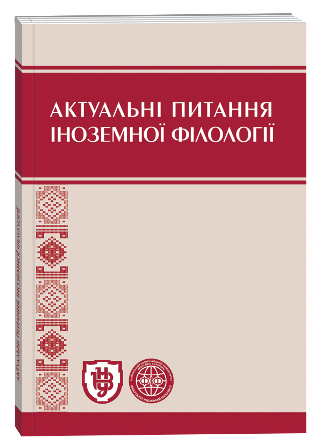HASHTAGS DENOTING DISTANCE LEARNING: LEXICAL, SEMANTIC AND FUNCTIONAL PECULIARITIES
DOI:
https://doi.org/10.32782/2410-0927-2020-13-19Keywords:
hashtag, lexical and semantic features, media linguistics, media discourse, Internet discourse, distance learningAbstract
The article identifies the main lexical, semantic and functional features of hashtags as the new means of interaction in the media space. The main types of media discourse, features of Internet discourse and the reasons for the transmission of information in it by different polycode systems were identified. The phenomenon of «hashtags» has been studied, the historical preconditions for the emergence of this phenomenon in the posts of Internet users were determined, and the main functions of hashtags in social networks were identified. New hashtags, denoting distance learning, were researched. The main trends in the media space in 2020, related to the lexical and semantic features of hashtags, were identified. In accordance with the principles of the qualitative method, hashtags about distance learning were selected, and the inductive method allowed to classify the relevant factual material. According to the methods of theoretical generalization, grouping and comparison, a multifaceted analysis of hashtags about distance learning was conducted. A comprehensive analysis of the system of new hashtags denoting distance learning, which emerged in 2020, was conducted. The analysis of these elements of the media space allowed to single out hashtags that express the subjective attitude of users to the phenomenon of «Distance Learning»; hashtags that perform a pre-classification function; a set of hashtags that do not have a pragmatic component of meaning; hashtags that thematically mark posts; frame-building hashtags; dissemination hashtags. Groups of commercial hashtags, that are used not only in private publications, have been identified. Various functions of hashtags about distance learning have been identified, which include categorization, pre-classifying and characterizing functions, representative function, co-reference function. The peculiarities of the ideological content of hashtags, which are not directly related to online education, but are only partially connected with the topic of learning, were revealed. Although such hashtags are not semantically related to the content of Internet users' posts, they are often combined with different sets of hashtags to reach the target audience.
References
Bohuslavskaya, Vera and Bohuslavskyi, Ihor. 2017. “Mediatekst i kheshtegi: tsyfrovaya transformatsiya SMI”. Humanytarnyi vektor, 51–58. Moscow.
Castañeda, Manuel. 2020. “What are Hashtags and, why do you need them.” URL: https://manuelcastanedamolido. medium.com/what-are-hashtags-and-why-do-you-need-them-442f7cb92ebf
Crystal, David. 2017. Language and the internet. Cambridge: Cambridge University Press.
Davydyuk, Nadiya. 2016. “Hra u slova ta zi slovamy: politychni otsinni kheshtehy u frantsuzkomu Tvitter-dyskursi (na prykladi kheshtehovysvitlennia peredvyborchoi kampanii u Frantsii u 2014 rotsi)”. Naukovyi visnyk Mizhnarodnoho humanitarnoho universytetu. Seriia: Filolohiya 24(2): 17–20. URL: http://nbuv.gov.ua/UJRN/ Nvmgu_filol_2016_24(2)__7.
Dijk, Teun A. Van. “Context and Cognition”. Discourse and Context 56–110.
Dobrosklonskaya, Tatiana. 2005. Medialingvistika: sistemnyi podkhod k izuchenyiu yazyka SMI. Moscow: Editorial.
Gee, James Paul. 1999. An introduction to discourse analysis: Theory and method. London: Routledge.
Karpenko, Yuriy. 2006. “Kohnityvna onomastyka yak napryamok piznannya vlasnykh nazv”. PhD diss., Kyiv.
Navoloka, Yulia. 2017. “Funktsii kheshtegov v sovremennoi rossiyskoy reklame (na materiale reklamy v sotsialnoy seti Instagram)”. Izvestiya Yuzhnogo federalnoho universiteta. Filologicheskie nauki 4: 145‒153.
Polishchuk, Olena and Svintsitska, Olena. 2008. “Infosfera Ukrainy: osoblyvosti mas-mediinoho dyskursu u konteksti estetychnoi informatsii”. Istoriya. Filosofiia. Relihiieznavstvo 2: 56–59.
Potapenko, Serhiy. 2009. Suchasnyi anhlomovnyi media-dyskurs: linhvokohnityvnyi i motyvatsiinyi aspekty: monohrafiia. Nizhyn: NDU imeni Mykoly Hoholia.
Rauschnabel, Philipp and Sheldon Pavica, Herzfeldt Erna. 2019. “What motivates users to hashtag on social media?” Psychology and Marketing 36(1): 1–16. DOI: 10.1002/mar.21191
Romanov, Oleg. 2017. Ontologicheskie i gnoseologicheskie problemy filosofii Interneta (Genezis i sintez fundamentalnykh idei). URL: http://www.dslib.net/ontologia/ontologicheskie-i-gnoseologicheskie-problemy-filosofii-interneta.html.
Shevliakova, Yulia. 2013. Osoblyvosti dyskursu Internet-ZMI (na materiali anhlomovnykh on-lain zhurnaliv dlia pidlitkiv). Naukovi zapysky Natsionalnoho universytetu «Ostrozka akademiia». Seriia «Filolohichna» 38: 239–242.
Volf, Olesia. 2017. “Funktsii kheshtega v zhurnalistskom mediatekste (na primere postov gazety «Shans» v sotsialnoy seti «VKontakte»)”. Kommunykatsyya. Kultura. Moscow.
Zheltukhina, Marina. 2016. “Sovremennyi mediadiskurs i mediakultura vozdeistviya”. Verkhnevolzhskiy filologicheskiy vestnik 4: 154–159.







